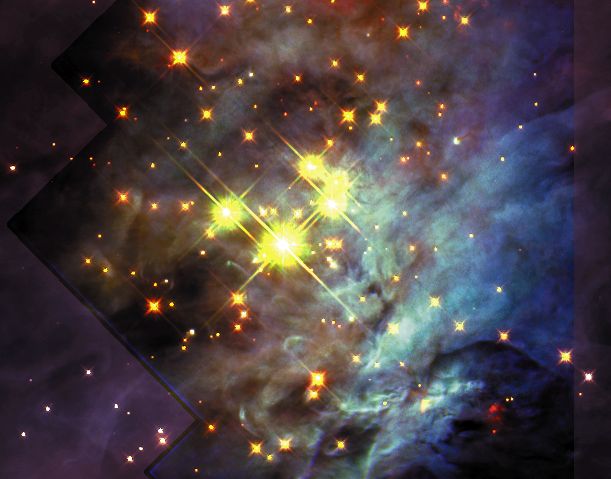Credit & Copyright: G. Schneider
(UofA),
K. L. Luhman
(CfA), et al.,
NICMOS IDT,
NASA
WFPC2 data: C. O'Dell and S. Wong (Rice)
Explanation:
The bright stars above are well known as heart
of the Trapezium, an
open cluster
of stars in the center of the
Orion Nebula.
The many dim objects, however, are not well known,
and have come to attention only on
recent images in
infrared light.
These dim objects are thought to be
brown dwarfs and
free-floating planets.
Brown dwarfs are stars too puny to create energy
in their core by
fusing
hydrogen into
helium.
Although many more
brown dwarfs
than hot stars have now been
found in Orion,
their very low masses make them inadequate
to compose much of the
dark matter expected in
galaxies and the
Universe.
The above false-color mosaic
combines infrared and visible light images
of the Trapezium from the Hubble Space Telescope.
Faint brown dwarfs with masses as small as about one percent the mass of the sun
are seen in the infrared data.
Also visible
are complex lanes of hot gas (appearing in blue) and cooler fine
dust that blocks, glows and
reflects nearby starlight.
WFPC2 data: C. O'Dell and S. Wong (Rice)
1999 2000 2001 2002 2003 2004 2005 2006 2007 2008 2009 2010 2011 2012 2013 2014 2015 2016 2017 2018 2019 2020 2021 2022 2023 2024 2025 |
Январь Февраль Март Апрель Май Июнь Июль Август Сентябрь Октябрь Ноябрь Декабрь |
NASA Web Site Statements, Warnings, and Disclaimers
NASA Official: Jay Norris. Specific rights apply.
A service of: LHEA at NASA / GSFC
& Michigan Tech. U.
|
Публикации с ключевыми словами:
Orion - trapezium - brown dwarf
Публикации со словами: Orion - trapezium - brown dwarf | |
См. также:
Все публикации на ту же тему >> | |
